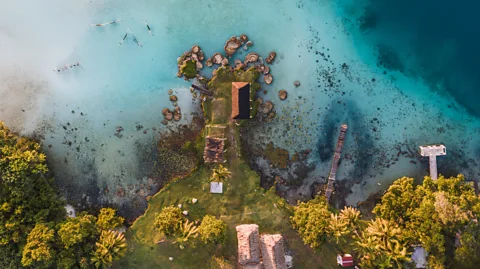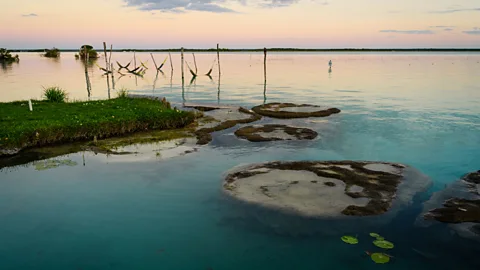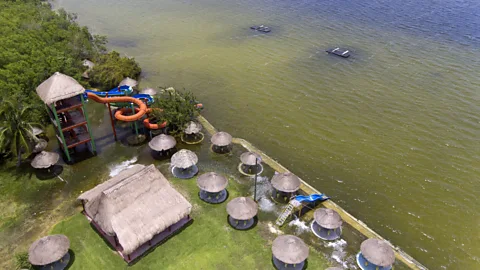Mexico's three-billion-year-old underwater lifeforms
 Pola Damonte/Getty Images
Pola Damonte/Getty ImagesFamous for its brilliant seven shades of blue, Lake Bacalar is home to an ancient population of stromatolites that are around 3.5 billion years old.
The beauty of Lake Bacalar, according to Claudio Del Valle, goes deeper than the Mexican lagoon's seven brilliant shades of blue, which range from bright turquoise to deep cobalt. Actually, the local tour guide says, up to 100m deeper – to the limestone bottom of the lake, which is home to the oldest life on the planet. Del Valle says that the most important thing when visiting the long, skinny lake near the Belize border is to leave no trace. He spent years taking groups on stand-up paddle boarding tours before dawn as the sun threw early light over the lagoon and sparkling thalassic hues matured out of the inky night.
"Thanks to the paddle boarding, I had the chance to explore most of the lagoon… it was so unique, so majestic, so beautiful," he said. "The clarity of the water makes this unique colouration of blue to green; it was delightful just to appreciate."
But the "Lake of Seven Colours" is under grave threat, Del Valle says, which could not only permanently change the colour of the lake but also lead to the destruction of an ancient population of stromatolites, a living fossil that predates humans, dinosaurs and even plants.
Del Valle moved to Bacalar in 2017 following the 7.1-magnitude Puebla earthquake, which left him with post-traumatic stress. On the advice of a psychologist friend, he departed his home of San Cristóbal de las Casas, 700km south-west of Bacalar, in search of a more tranquil environment. He was blown away by what he found. "It was paradise," he said, of seeing Bacalar's lagoon for the first time. "You couldn't believe the sunrise and the sunset, every one was so unique. But now I can see what is happening… it breaks my heart, it is wrong."
 Marco Bottigelli/Getty Images
Marco Bottigelli/Getty ImagesLake Bacalar has been moving towards an ecological disaster for the past decade, according to Dr Luisa Falcón, a microbial ecologist at the National Autonomous University of Mexico in Merida. In November 2015, Mexico's federal environmental protection agency issued a pollution alert for the lake. The problem came to a head in June 2020, when Lake Bacalar's rich thalassic hues turned a dull brown. It still has not made a full recovery.
But if nothing is done, the damage could go far beyond the aesthetics of the brilliantly hued water, Falcón warns. Bacalar is home to the largest freshwater microbialite reef in the world – rock-like structures made by thousands of microbes that precipitate carbonate minerals. "Bacalar's microbialites have an age range between decades to more than 9,000 years old," she said. But it's the microbialite's living fossil counterpart, the stromatolites, that date back to "approximately 3.5 billion years old", making Bacalar's population the oldest evidence of life on Earth.
The stromatolites resemble cauliflower – big, pillowy beige structures that grow upwards from the lagoon's limestone bottom of the lake. They look like rocks, but they are actually living things. The sediment layers itself millimetre by millimetre, with the aid of photosynthesising organisms called cyanobacteria, until the structures turn into a rocky underwater growth that can be seen on the surface of shallow water.
You may also be interested in:
• The Earth's oldest living lifeforms
The cauliflower-like stromatolites only still exist in a few locations globally – and Bacalar's population reveal history frozen in time, such as the temperature or the geochemical composition of the water millions of years ago. That's because they actually preserve the physicochemical conditions of the water in their incredibly slow sedimentation process. Crucially, stromatolites also help recycle elements. The microbes that make up a stromatolite take carbon from the CO2 in the air and put it into the lake floor's carbonate to store it. Like trees, their above-water counterpart, stromatolites actively improve our environment.
But the problem facing stromatolites is two-fold, Falcón said. The lake is fed by a 450km underground river that is part of the world's largest water cave and tunnel system along the Yucatan Peninsula. This is actually good for stromatolites – the carbonate rock of the tunnels is thought to make them grow larger than normal, pillowing out on the surface of the lagoon.
 Gerard Puigmal/Getty Images
Gerard Puigmal/Getty ImagesBut karstic environments, where groundwater flows through fractures and cave systems interconnect water bodies, also leave the stromatolites more vulnerable to upstream change. And deforestation of the rainforest upstream from the lagoon has increased "exponentially" in the last decade due to unsustainable agricultural practices, says Falcón. That has led to a rise in sediments, pesticides and fertilisers making their way into the water during the rainy season. High levels of nitrogen and ammonium are being recorded in the lagoon, especially near the town. The makeup of the water is changing – and algae and molluscs are multiplying at a rapid rate. So far, no research has demonstrated that microbialite communities can recover from environmental damage in the short term.
The local tourism industry has played a role in Bacalar's degradation. "Bacalar as a tourist destination has received increased attention but is without the necessary urban planning, including sufficient sewage treatment and sanitary facilities." A study Falcón co-authored found high amounts of Firmicutes, a bacteria found in the human intestine, in the lagoon.
In addition, De Valle says a roaring tourism industry on the lake, including boats, kayaks, jet skis, anchors, fin kicks and even people standing at the lagoon's edge, is seeing the surface of stromatolites broken. When their surface is punctured, they die, just like coral reefs. "There are plenty of hostels, hotels, Airbnbs, many don't care about the stromatolites and the mangroves that allow the natural resources of the lagoon to regenerate," he said.
In a way, Del Valle says, as a former tour guide, he was part of the problem. Bacalar, just south of Quintana Roo's popular tourist spots Cancun, Tulum and Playa del Carmen, was attracting close to 100,000 tourists a season in recent years. And local operators have cashed in. "We were making ments and publicity to make that place more famous and popular, knowing that it doesn't have the infrastructure, the plans, the project, to protect the lagoon," he said.
 Medios y Media/Getty Images
Medios y Media/Getty ImagesLocal researcher and biologist Silvana Ibarra, member of the Citizen and Scientific Council for the Restoration and Preservation of the Bacalar Aquifer and Lagoon System, agrees. "The growth of tourists in Bacalar is 600% in three years and the hosts are not prepared: they do not accept the carrying capacity of the ecosystem," she said.
But slowed tourist activity in the past 12 months has given the 42km-long expanse of lake a chance to recover. "These problems started a decade ago and worsened two years ago, but the improvement during the pandemic was shown in that we again saw animals such as the river otter," Ibarra said. This slowed tourism activity has also seen the lagoon's colours stirring back to life.
With more sustainable tourism, Lake Bacalar can continue its recovery and restore its reputation as the "Lake of Seven Colours". And there are several easy ways for travellers to do this, Ibarra said. She advises never to touch, step or sit on the stromatolites in the lagoon. She says visitors should enter the lagoon barefoot, and never while wearing sunscreen or makeup, as both can bleach the stromatolites. More broadly, she said, "stay in eco-friendly hotels, and very, very importantly: reduce your waste."
"Come knowing that it is a fragile natural sanctuary that must be treated with care," she said. "It is important to protect the lagoon and especially to adapt to the territory, because otherwise, its beauty and natural services will be lost."
In the meantime, before travel returns to pre-pandemic levels, Del Valle says it is up to the local tourism operators to save the crystalline lagoon – the largest in the Yucatan Peninsula. Del Valle has approached many of the operators surrounding the lagoon to help make their tourism offerings more sustainable. "The locals, they own all the motorboats in the lagoon, they are in the hundreds. I have talked several times with many of them to persuade them," he said. "I offered them, for free, to train them to do paddle tours, to do sailing tours, things that don't affect the lagoon."
 Benedicte Desrus/Alamy
Benedicte Desrus/Alamy"Hopefully when the time is right, there's going to be a change in society, and with that the most important thing, which is nature, will start to recover," he said.
Thinking back to his first impressions of the then-glorious Lake Bacalar, at a time when he was struggling with his own trauma, Del Valle pauses. "It really started to make me well [again]," he said. In a way, he continued, the now-threatened lagoon was a catalyst for his own healing.
"It was the first time in my adult life that I was having this feeling of belonging to a ‘thing'." Hopefully, with a little help, he added, Mexico's lake of seven colours will heal too.
more than three Nature’s Curiosities is a BBC Travel series that offers a close-up look at the natural world, taking adventurous travellers on an unexpected journey of exploration.
--
more than three million BBC Travel fans by liking us on Facebook, or follow us on Twitter and Instagram.
If you liked this story, sign up for the weekly bbc.com features newsletter called "The Essential List". A handpicked selection of stories from BBC Future, Culture, Worklife and Travel, delivered to your inbox every Friday.
{"image":{"pid":""}}
